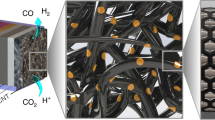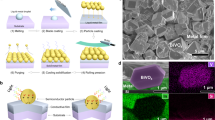Abstract
Producing hydrogen through solar water splitting requires the coverage of large land areas. Abundant metal-based molecular catalysts offer scalability, but only if they match noble metal activities. We report on a highly active p-GaInP2 photocathode protected through a 35-nm TiO2 layer functionalized by a cobaloxime molecular catalyst (GaInP2–TiO2–cobaloxime). This photoelectrode mediates H2 production with a current density of ∼9 mA cm−2 at a potential of 0 V versus RHE under 1-sun illumination at pH 13. The calculated turnover number for the catalyst during a 20-h period is 139,000, with an average turnover frequency of 1.9 s−1. Bare GaInP2 shows a rapid current decay, whereas the GaInP2–TiO2–cobaloxime electrode shows ≤5% loss over 20 min, comparable to a GaInP2–TiO2–Pt catalyst particle-modified interface. The activity and corrosion resistance of the GaInP2–TiO2–cobaloxime photocathode in basic solution is made possible by an atomic layer-deposited TiO2 and an attached cobaloxime catalyst.
This is a preview of subscription content, access via your institution
Access options
Subscribe to this journal
Receive 12 print issues and online access
$259.00 per year
only $21.58 per issue
Buy this article
- Purchase on Springer Link
- Instant access to full article PDF
Prices may be subject to local taxes which are calculated during checkout





Similar content being viewed by others
References
Turner, J. A. Sustainable hydrogen production. Science 305, 972–974 (2004).
Turner, J. A. A realizable renewable energy future. Science 285, 687–689 (1999).
Lewis, N. S. & Nocera, D. G. Powering the planet: chemical challenges in solar energy utilization. Proc. Natl Acad. Sci. USA 103, 15729–15735 (2006).
Huda, M. N., Al-Jassim, M. M. & Turner, J. A. Mott insulators: an early selection criterion for materials for photoelectrochemical H2 production. J. Renew. Sustain. Energy 3, 053101 (2011).
Gu, J. et al. p-type CuRhO2 as a self-healing photoelectrode for water reduction under visible light. J. Am. Chem. Soc. 136, 830–833 (2014).
Krawicz, A. et al. Photofunctional construct that interfaces molecular cobalt-based catalysts for H2 production to a visible-light-absorbing semiconductor. J. Am. Chem. Soc. 135, 11861–11868 (2013).
Huang, J., Mulfort, K. L., Du, P. & Chen, L. X. Photodriven charge separation dynamics in CdSe/ZnS core/shell quantum dot/cobaloxime hybrid for efficient hydrogen production. J. Am. Chem. Soc. 134, 16472–16475 (2012).
Khaselev, O. & Turner, J. A. A monolithic photovoltaic-photoelectrochemical device for hydrogen production via water splitting. Science 280, 425–427 (1998).
Khaselev, O. & Turner, J. A. Electrochemical stability of p-GaInP2 in aqueous electrolytes toward photoelectrochemical water splitting. J. Electrochem. Soc. 145, 3335–3339 (1998).
Deutsch, T., Turner, J. A., Wang, H. & Dinh, H. US DOE Hydrogen and Fuel Cells Program 2014 Annual Progress Report (US Department of Energy, 2014); http://www.hydrogen.energy.gov/pdfs/progress14/ii_d_1_deutsch_2014.pdf.
Moore, G. F. & Sharp, I. D. A noble-metal-free hydrogen evolution catalyst grafted to visible light-absorbing semiconductors. J. Phys. Chem. Lett. 4, 568–572 (2013).
Artero, V. & Saveant, J.-M. Toward the rational benchmarking of homogeneous H2-evolving catalysts. Energy Environ. Sci. 7, 3808–3814 (2014).
Artero, V., Chavarot-Kerlidou, M. & Fontecave, M. Splitting water with cobalt. Angew. Chem. Int. Ed. 50, 7238–7266 (2011).
Dempsey, J. L., Brunschwig, B. S., Winkler, J. R. & Gray, H. B. Hydrogen evolution catalyzed by cobaloximes. Acc. Chem. Res. 42, 1995–2004 (2009).
Artero, V. & Fontecave, M. Solar fuels generation and molecular systems: is it homogeneous or heterogeneous catalysis? Chem. Soc. Rev. 42, 2338–2356 (2013).
Mulfort, K. L., Mukherjee, A., Kokhan, O., Du, P. & Tiede, D. M. Structure–function analyses of solar fuels catalysts using in situ X-ray scattering. Chem. Soc. Rev. 42, 2215–2227 (2013).
Oktyabrsky, S. & Peide, D. Y. Fundamentals of III–V Semiconductor MOSFETs (Springer, 2010).
O’regan, B. & Grätzel, M. A low-cost, high-efficiency solar cell based on dye-sensitized colloidal TiO2 films. Nature 353, 737–740 (1991).
Mathew, S. et al. Dye-sensitized solar cells with 13% efficiency achieved through the molecular engineering of porphyrin sensitizers. Nature Chem. 6, 242–247 (2014).
Niilisk, A. et al. Structural study of TiO2 thin films by micro-Raman spectroscopy. Cent. Eur. J. Phys. 4, 105–116 (2006).
Chen, Y. W. et al. Atomic layer-deposited tunnel oxide stabilizes silicon photoanodes for water oxidation. Nature Mater. 10, 539–544 (2011).
Hu, S. et al. Amorphous TiO2 coatings stabilize Si, GaAs, and GaP photoanodes for efficient water oxidation. Science 344, 1005–1009 (2014).
Walter, M. G. et al. Solar water splitting cells. Chem. Rev. 110, 6446–6473 (2010).
Lakadamyali, F., Reynal, A., Kato, M., Durrant, J. R. & Reisner, E. Electron transfer in dye-sensitised semiconductors modified with molecular cobalt catalysts: photoreduction of aqueous protons. Chem. Eur. J. 18, 15464–15475 (2012).
Nazeeruddin, M. K. et al. Conversion of light to electricity by cis-X2bis (2, 2′-bipyridyl-4, 4′-dicarboxylate) ruthenium (II) charge-transfer sensitizers (X = Cl-, Br-, I-, CN-, and SCN-) on nanocrystalline titanium dioxide electrodes. J. Am. Chem. Soc. 115, 6382–6390 (1993).
Bach, U. et al. Solid-state dye-sensitized mesoporous TiO2 solar cells with high photon-to-electron conversion efficiencies. Nature 395, 583–585 (1998).
Yao, Q.-H., Meng, F.-S., Li, F.-Y., Tian, H. & Huang, C.-H. Photoelectric conversion properties of four novel carboxylated hemicyanine dyes on TiO2 electrode. J. Mater. Chem. 13, 1048–1053 (2003).
Andreiadis, E. S. et al. Molecular engineering of a cobalt-based electrocatalytic nanomaterial for H2 evolution under fully aqueous conditions. Nature Chem. 5, 48–53 (2013).
Bae, E. et al. Effects of surface anchoring groups (carboxylate vs phosphonate) in ruthenium-complex-sensitized TiO2 on visible light reactivity in aqueous suspensions. J. Phys. Chem. B 108, 14093–14101 (2004).
Park, H., Bae, E., Lee, J.-J., Park, J. & Choi, W. Effect of the anchoring group in Ru-bipyridyl sensitizers on the photoelectrochemical behavior of dye-sensitized TiO2 electrodes: carboxylate versus phosphonate linkages. J. Phys. Chem. B 110, 8740–8749 (2006).
Hanson, K., Losego, M. D., Kalanyan, B., Parsons, G. N. & Meyer, T. J. Stabilizing small molecules on metal oxide surfaces using atomic layer deposition. Nano Lett. 13, 4802–4809 (2013).
Heller, A. Hydrogen-evolving solar cells. Science 223, 1141–1148 (1984).
Lien, S.-Y., Wuu, D.-S., Yeh, W.-C. & Liu, J.-C. Tri-layer antireflection coatings (SiO2/SiO2–TiO2/TiO2) for silicon solar cells using a sol–gel technique. Sol. Energy Mater. Sol. Cells 90, 2710–2719 (2006).
Lee, M. H. et al. p-type InP nanopillar photocathodes for efficient solar-driven hydrogen production. Angew. Chem. 124, 10918–10922 (2012).
Paracchino, A., Laporte, V., Sivula, K., Grätzel, M. & Thimsen, E. Highly active oxide photocathode for photoelectrochemical water reduction. Nature Mater. 10, 456–461 (2011).
Seger, B. et al. Using TiO2 as a conductive protective layer for photocathodic H2 evolution. J. Am. Chem. Soc. 135, 1057–1064 (2013).
Burke, L. & Roche, M. Hydrous oxide formation on platinum—a useful route to controlled platinization. J. Electroanal. Chem. Interfacial Electrochem. 164, 315–334 (1984).
Neale, N. R., Kopidakis, N., van de Lagemaat, J., Grätzel, M. & Frank, A. J. Effect of a coadsorbent on the performance of dye-sensitized TiO2 solar cells: shielding versus band-edge movement. J. Phys. Chem. B 109, 23183–23189 (2005).
Biesinger, M. C. et al. Resolving surface chemical states in XPS analysis of first row transition metals, oxides and hydroxides: Cr, Mn, Fe, Co and Ni. Appl. Surf. Sci. 257, 2717–2730 (2011).
Le Goff, A. et al. From hydrogenases to noble metal–free catalytic nanomaterials for H2 production and uptake. Science 326, 1384–1387 (2009).
Trogler, W. C., Stewart, R. C., Epps, L. A. & Marzilli, L. G. Cis and trans effects on the proton magnetic resonance spectra of cobaloximes. Inorg. Chem. 13, 1564–1570 (1974).
Abdulagatov, A. et al. Al2O3 and TiO2 atomic layer deposition on copper for water corrosion resistance. ACS Appl. Mater. Interfaces 3, 4593–4601 (2011).
Chandiran, A. K., Abdi-Jalebi, M., Nazeeruddin, M. K. & Grätzel, M. Analysis of electron transfer properties of ZnO and TiO2 photoanodes for dye-sensitized solar cells. ACS Nano 8, 2261–2268 (2014).
Luka, G. et al. Kinetics of anatase phase formation in TiO2 films during atomic layer deposition and post-deposition annealing. CrystEngComm 15, 9949–9954 (2013).
Elam, J., Zinovev, A., Pellin, M. J., Comstock, D. J. & Hersam, M. C. Nucleation and growth of noble metals on oxide surfaces using atomic layer deposition. ECS Trans. 3, 271–278 (2007).
Dasgupta, N. P., Liu, C., Andrews, S., Prinz, F. B. & Yang, P. Atomic layer deposition of platinum catalysts on nanowire surfaces for photoelectrochemical water reduction. J. Am. Chem. Soc. 135, 12932–12935 (2013).
Oh, I., Kye, J. & Hwang, S. Enhanced photoelectrochemical hydrogen production from silicon nanowire array photocathode. Nano Lett. 12, 298–302 (2011).
Seabold, J. A., Zhu, K. & Neale, N. R. Efficient solar photoelectrolysis by nanoporous Mo: BiVO4 through controlled electron transport. Phys. Chem. Chem. Phys. 16, 1121–1131 (2014).
Seah, M. Post-1989 calibration energies for X-ray photoelectron spectrometers and the 1990 Josephson constant. Surf. Interface Anal. 14, 488 (1989).
Wallart, X., Henry de Villeneuve, C. & Allongue, P. Truly quantitative XPS characterization of organic monolayers on silicon: study of alkyl and alkoxy monolayers on H–Si (111). J. Am. Chem. Soc. 127, 7871–7878 (2005).
Acknowledgements
We gratefully acknowledge H. Doscher for supplying the GaInP2 wafers, C. Xiao for AFM measurements, L. Gedvilas for ATR-IR measurements, C. Macomber for ICP-MS measurements, S. George for advice on ALD and H. Wang and T. Deutsch for useful discussions. This material is based on work supported by the US Department of Energy, Office of Science, Office of Basic Energy Sciences, Solar Photochemistry Program under Contract Number DE-AC36-08GO28308. J.L.Y. acknowledges NSF Graduate Research Fellowship Grant No. DGE 1144083.
Author information
Authors and Affiliations
Contributions
J.G., Y.Y., N.R.N. and J.A.T. designed the research; J.G. and Y.Y. performed the research; J.L.Y. performed the ALD deposition; and K.X.S. performed the XPS study. J.G., Y.Y., N.R.N. and J.A.T. co-wrote the paper.
Corresponding author
Ethics declarations
Competing interests
The authors declare no competing financial interests.
Supplementary information
Supplementary Information
Supplementary Information (PDF 2224 kb)
Rights and permissions
About this article
Cite this article
Gu, J., Yan, Y., Young, J. et al. Water reduction by a p-GaInP2 photoelectrode stabilized by an amorphous TiO2 coating and a molecular cobalt catalyst. Nature Mater 15, 456–460 (2016). https://doi.org/10.1038/nmat4511
Received:
Accepted:
Published:
Issue Date:
DOI: https://doi.org/10.1038/nmat4511
This article is cited by
-
Interfacial interaction promoted titanium oxide-based organic-inorganic nanoheterojunctions by chiral host-guest binding
Communications Materials (2023)
-
Assessment of the technological viability of photoelectrochemical devices for oxygen and fuel production on Moon and Mars
Nature Communications (2023)
-
Manipulating metal-oxygen local atomic structures in single-junctional p-Si/WO3 photocathodes for efficient solar hydrogen generation
Nano Research (2021)
-
Enhancing photovoltages at p-type semiconductors through a redox-active metal-organic framework surface coating
Nature Communications (2020)
-
High performance III-V photoelectrodes for solar water splitting via synergistically tailored structure and stoichiometry
Nature Communications (2019)



